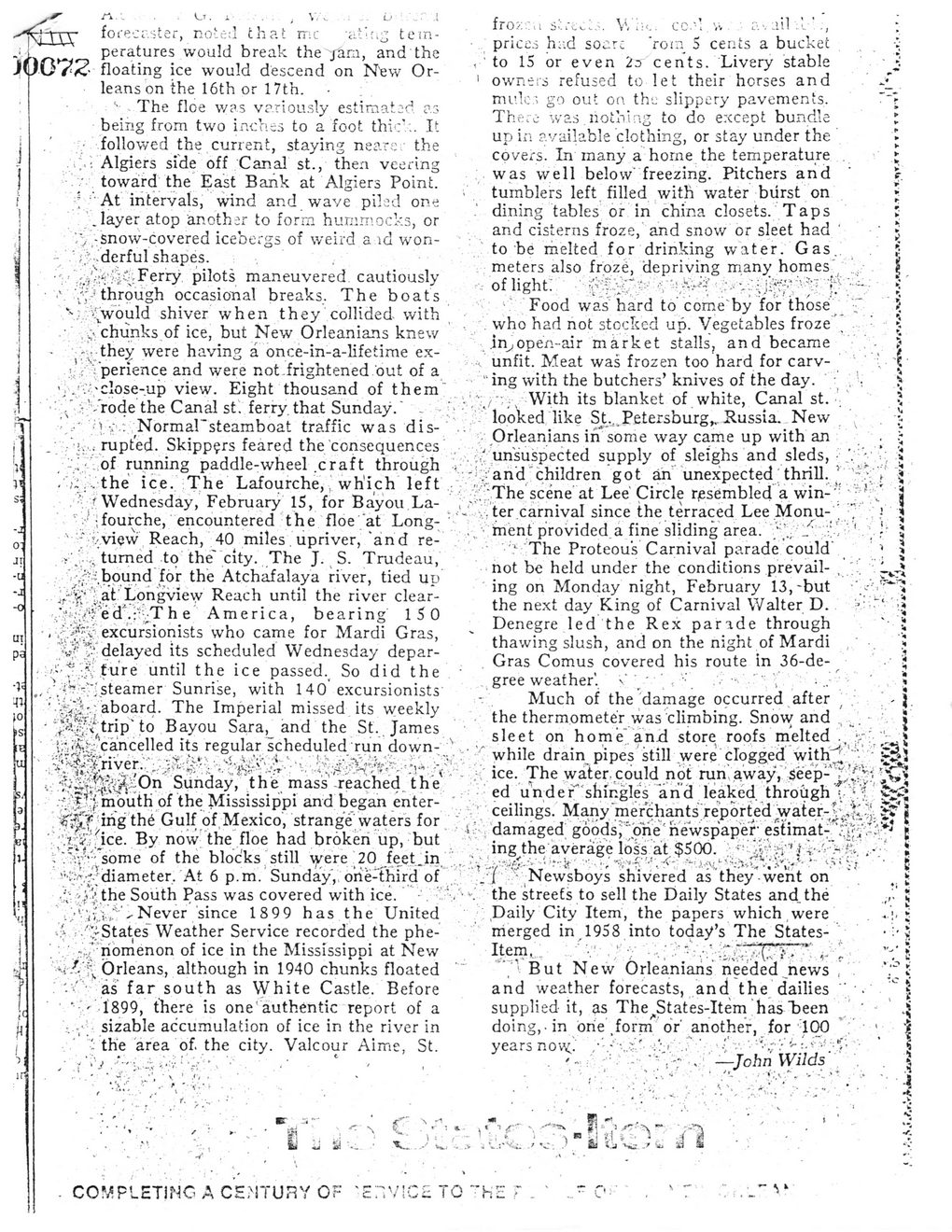This text was obtained via automated optical character recognition.
It has not been edited and may therefore contain several errors.
^i€nx it)07‘2 i ; V. , . .. L> .1 forecaster, noted that me -atit." temperatures would break the /am, and the floating ice would descend on New Orleans on the 16th or 17th. '■ The floe was variously estimatori as being from two inches to a foot thicV.. It followed the current, staying nearer the •. Algiers side off Canal st., then veering toward the East Bank at Algiers Point. At intervals, wind and wave pikd one .layer atop another to form hummocks, or -snow-covered icebergs of weird a id won- - ' ^' ..derful shapes. Ferry, pilots maneuvered cautiously • '.Vthrough occasional breaks. The boats -;vwould shiver when they collided with • chunks of ice, but New Orleanians knew - r.vthey were having a once-in-a-lifetime ex- ■ ' perience and were not-frightened out of a 5;'close-up view. Eight thousand of them" : Vrode the Canal st. ferry, that Sunday.' -v o.; . NormaPsteamboat traffic was dis-rupted. Skippers feared the consequences / of running paddle-wheel .craft through ... / .'-". . the ice. The Lafourche,,. which left . \ * Wednesday, February IS, for Bayou La- , ' -;fourche, encountered the floe *at Long-7" • '•:-'.-'?>.view Reach, 40 miles . upriver, 'and re-' ? turned to the' city. The J. S. Trudeau, bound for the Atchafalaya river, tied up" •• Longview Reach until the river clear- .p^T h e America, bearing 15 0 - -excursionists who came for Mardi Gras, delayed its scheduled Wednesday depar-ture until the ice passed.t So did the , steamer' Sunrise, with 140* excursionists ' >^r.'aboard. The Imperial missed its weekly ' trip'to Bayou Sara, and the St. James fro?:-.:.i sictci.-. Wh<.. co.*-!. v» - a>. ail prices had soar: rom 5 cents a bucket to 15 or even 2z> cents. Livery stable 1 ow'ners refused to let their horses and mule.'* go out on the slippery pavements. There- was.nothing to do except bundle up in available clothing, or stay under the covers. In many a home the temperature was well below freezing. Pitchers and tumblers left filled with water burst on dining tables or in china closets. Taps and cisterns froze, and snow or sleet had to be melted for drinking water. Gas. meters also froze, depriving many homesy r of light. -'•Vj^'Y'Vrt,: Food was hard to come'by for those: . who had not stocked up. Vegetables froze".' . jn^open-air market stalls, and became unfit. Meat was frozen too hard for carving with the butchers’ knives of the day. v'';> With its blanket of white, Canal st. looked like Stu.Petersburg,. Russia. New Orleanians in some way came up with an t. unsuspected supply of sleighs and sleds, and children got an unexpected thrill. 5 ’;r;The scene at Lee' Circle resembled a win- ’• v. ter carnival since the terraced Lee Monu- ’ ■ ment provided a fine sliding area, -y^:. 'x The Proteou’s Carnival parade could' not be held under the conditions prevail- , ing on Monday night, February 13,-but Vv the next day King of Carnival Walter D. - Denegre led the Rex parade through thawing slush, and on the night of Mardi Gras Comus covered his route in 36-de-gree weather'. / / ' . \ : , • Much of the damage occurred after the thermometer was'climbing. Snow and , ..... • sleet on home" anil store roofs melted vl -« > 2 * * "4 mouth of the Mississippi and began enter-ihg the Gulf of Mexico, strange waters for . ;Vr;K jce. By now the floe had broken up, but t '‘^Y^'some of the blocks still ^/ere 20 fe.et.in, . r, si.^W:-*diameter. At 6 p.m. Sunday, oiie-third of .ivi&the South Pass was covered with ice. vV* Never since 1899 has the United -X>/$ States-Weather Service recorded the phe->_r:nomenon of ice in the Mississippi at New •4-iOrleans, although in 1940 chunks floated ’'v'• as far south as White Castle. Before ' ' ' 1899, there is one authentic report of a sizable accumulation of ice in the river in 1 the area of. the city. Valcour Aime, St. while drain pipes still were clogged with^• , ice. The water, could not run, away, Seep-ed undei^ shingles and leaked through ceilings. Many'merchants reported water-t^.^ 'damaged goods^one‘newspaper'estimatf.'’.^p;-ing the average loss at $500. ;■ r - f ^ , Newsboys shivered as they’went on the streets to sell the Daily States and_the . Daily City Item, the papers which were merged in 1958 into today’s The States-Item, . '• -v - ■ .- 7'.. But New Orleanians needed^news , and weather forecasts, and the dailies ' . supplied it, as The^States-Item has "been doing, in one .form or' another, for 100 ’' 1 years now. /• • \" ' ■[' ■■ '• ■■■ ■ . ' - ; - ;;V-: - —John Wilds ^ I; i o Sr; S :C h k v i i a j % C. P ~ \ 1 '■) « V.l i - 3 . ai I,j ■sl: J ' COMPLETiNC A CEiTTURY OF 'EHV1CE TO ”h'E

New Orleans and Louisiana Document (068)
